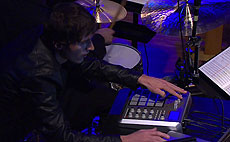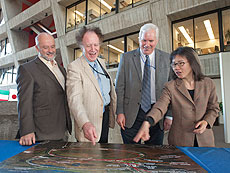|
Have a safe day!
Tuesday, Jan. 31
3:30 p.m.
DIRECTOR'S COFFEE BREAK - 2nd Flr X-Over
THERE WILL BE NO ACCELERATOR PHYSICS AND TECHNOLOGY
SEMINAR THIS WEEK
Wednesday, Feb. 1
3:30 p.m.
DIRECTOR'S COFFEE BREAK - 2nd Flr X-Over
4 p.m.
Fermilab Colloquium -
One West
Speaker: Jasper Kirkby, CERN
Title: Cosmic Rays, Climate and the CERN CLOUD Experiment
Click here for NALCAL,
a weekly calendar with links to additional information.
Upcoming conferences
|
|
Tuesday, Jan. 31
- Breakfast: Bagel sandwich
- Golden broccoli cheese soup
- Fish & chips
- Coconut crusted tilapia
- Burgundy beef tips
- La grande sandwich
- Assorted calzones
- Chicken fajitas
Wilson Hall Cafe Menu
|
|
Wednesday, Feb. 1
Lunch
- Pork Schnitzel w/ noodles and browned cabbage
- Apple strudel w/ cinnamon cream
Friday, Jan. 3
Dinner
Closed
Chez Leon Menu
Call x3524 to make your reservation.
|
|
Fermilab sounds debut in "Alternative Energy"
 |
| Composer Mason Bates performs a previous symphony, "Mothership," with the Chicago Symphony Orchestra. Watch a clip from that show here.
|
Editor's note: The Chicago Symphony Orchestra will perform contempory composer Mason Bates' newest symphony, "Alternative Energy," at 8 p.m. from Feb. 2 to Feb. 4 and Feb. 7. This piece features sounds collected at Fermilab last spring, including hums from refrigeration units, growls from transformers and the quenching of a Tevatron magnet.
Most Fermilab personnel have learned to ignore the ubiquitous booms, hums, growls and crackles of Fermilab machinery. But composer Mason Bates places these sounds center stage in his new piece "Alternative Energy."
"Alternative Energy" is an imaginative musical narrative that follows the evolution of energy and technology. The Chicago Symphony Orchestra will perform the piece at 8 p.m. from Feb. 2 through 4 and Feb. 7.
"The idea was that each movement would be separated by a hundred years, starting with old energy and moving to present and future energy," Bates said about his newest symphony. The first movement in the show uses scrap metal to evoke a junkyard.
Bates came to Fermilab last spring seeking inspiration for the present-day movement of his piece. He was not disappointed. Bates found a variety of sounds to give a modern-twist to his dynamic orchestral symphony.
"FermlLab exists at the intersection of technological power and human curiosity, and I wanted the symphony to include an example of massive energy used in a positive way. When we hear a surround-sound recreation of the Tevatron booting up - a massive machine spins around the orchestra- it is as if the crank on an old Model T suddenly grew to be several acres in size," Bates said.
Read more
—Sarah Charley
|
Does antimatter weigh more than matter?
From the University of California at Riverside newsroom, Jan. 26, 2012.
UC Riverside physicists have launched a lab experiment to find out the answer
Does antimatter behave differently in gravity than matter? Physicists at the University of California, Riverside have set out to determine the answer. Should they find it, it could explain why the universe seems to have no antimatter and why it is expanding at an ever increasing rate.
In the lab, the researchers took the first step towards measuring the free fall of "positronium" – a bound state between a positron and an electron. The positron is the antimatter version of the electron. It has identical mass to the electron, but a positive charge. If a positron and electron encounter each other, they annihilate to produce two gamma rays.
Physicists David Cassidy and Allen Mills first separated the positron from the electron in positronium so that this unstable system would resist annihilation long enough for the physicists to measure the effect of gravity on it.
"Using lasers we excited positronium to what is called a Rydberg state, which renders the atom very weakly bound, with the electron and positron being far away from each other," said Cassidy, an assistant project scientist in the Department of Physics and Astronomy, who works in Mills's lab.
Read more
|
Wacky physics: Why do particles have flavors?
From LiveScience.com, Jan. 26, 2012.
In this regular series, LiveScience explores some of the wildest, weirdest parts of our universe, from quantum oddities to hidden dimensions.
The building blocks of matter — fundamental particles — come in many more flavors than the basic few that make up the atoms we're familiar with.
Flavor is the name scientists give to different versions of the same type of particle. For instance, quarks (which make up the protons and neutrons inside atoms) come in six flavors: up, down, top, bottom, strange and charm. Particles called leptons, a category that includes electrons, also come in six flavors, each with a different mass.
But physicists are baffled as to why flavors exist at all, and why each flavor has different characteristics.
"This is known as the flavor problem," said JoAnne Hewett, a theoretical physicist at the SLAC National Accelerator Laboratory in Menlo Park, Calif. "Why are there so many flavors? Why do we have six types of quarks and six types of leptons, and why do they have the different masses that they do? We don't have a clue."
Read more
|
|
URA Council of Presidents
 |
| Fermilab Director Pier Oddone; John Kogut, DOE program manager; Jim Siegrist, head of the Office of High Energy Physics; and Fermilab Deputy Director Young-Kee Kim look over a plan for Fermilab. Photo: Reidar Hahn
|
The Universities Research Association's Council of Presidents took place on Jan. 25 in Washington DC. This yearly business meeting brought together the presidents of URA institutions or their representatives. At this meeting, I presented a report on the status of Fermilab. It was an opportunity for our laboratory to present our programs and plans and generate enthusiasm and support from senior university leaders.
The Council meeting also featured presentations by and discussions with policy makers. This year we had a stellar cast: John Holdren, director of the Office of Science and Technology Policy; Subra Suresh, director of the National Science Foundation; Steven Chu, Secretary of Energy; and the Honorable Randy Hultgren, Congressman for the 14th Congressional district, in which Fermilab resides.
The Presidential Administration and Congress both understand the vital importance of maintaining a strong science and technology enterprise in the United States. Science investments by the government have been maintained despite the difficult budgetary climate in our country. There were, of course, different perspectives represented in the presentations. The speakers representing the Administration all emphasized the impact of science on innovation and economic prosperity. Much of the emphasis was on science that can lead to improved energy technologies. The address by Rep. Hultgren placed a strong emphasis on fundamental science.
Later last week we hosted a visit by Jim Siegrist, head of the Office of High Energy Physics in DOE, and John Kogut, the DOE program manager with oversight of Fermilab facilities. The meetings were quite comprehensive, covering all aspects of the laboratory with an emphasis on management and facilities issues. They took a tour of our facilities that covered not only some of our recent projects but also much of the ageing infrastructure that we will revitalize in the next decade. We are very appreciative of the time our visitors spent understanding our laboratory, which is an important aspect of keeping the high-energy physics program successful within the Office of Science and beyond.
|
|